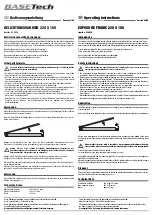
37
SETTING SQUELCH FOR
THE TRUNKING MODE
Your scanner automatically mutes the
audio during trunk scanning when it
decodes control channel data. Howev-
er, we recommend you turn
SQUELCH
clockwise and leave it set to a point
just after the hissing sound stops. This
lets the scanner quickly acquire the
data channel.
PROGRAMMING
TRUNKING
FREQUENCIES
You program trunking frequencies just
like non-trunked frequencies, except
that you must store the appropriate
mode (MO, ED, or LT) with each fre-
quency.
Notes:
• You can store only one trunked
EDACs and Motorola channel in a
bank. You can, however, mix LTR
and conventional channels in a
bank.
• If you are scanning UHF trunking
frequencies under the 512 MHz
range using subaudible data and
are not using a base frequency
and offset, lock out all data chan-
nels. See “Programming Motorola
Trunking Systems (UHF-Lo)” on
Page 38 and “Locking Out Chan-
nels, Frequencies, and Trunking
IDs” on Page 30. Turn off the
scanner to remove the lockouts.
• If you are programming trunked
frequencies for Motorola Type I
and hybrid systems, you must first
program the fleet map (see “Pro-
gramming Fleet Maps” on
Page 39).
• You must store frequencies using
the subaudible trunking method in
banks mode by mode.
Follow these steps to program trunked
frequencies.
1. Press
PROG
and select the bank,
then press
TRUNK
to enter the ID
program mode.
2. Repeatedly press
MODE
to select
LT
for EF Johnson,
MO
for Motor-
ola, or
ED
for the EDACS (GE/
Ericsson) system to scan. This
sets the talk group ID decoding
method to be used for the bank.
Notes:
• If you select
--
instead of
LT
,
MO
, or
ED
, the scanner does
not scan trunked frequencies.
Instead, you see:
• If you programmed a Motorola
Type I or Hybrid system, see
“Programming Fleet Maps” on
Page 39.
3. Press
PROG
to enter the program
mode.
4. Store the trunking frequencies into
subsequent channels in the same
20-196a.fm Page 37 Friday, June 2, 2000 3:48 PM














































